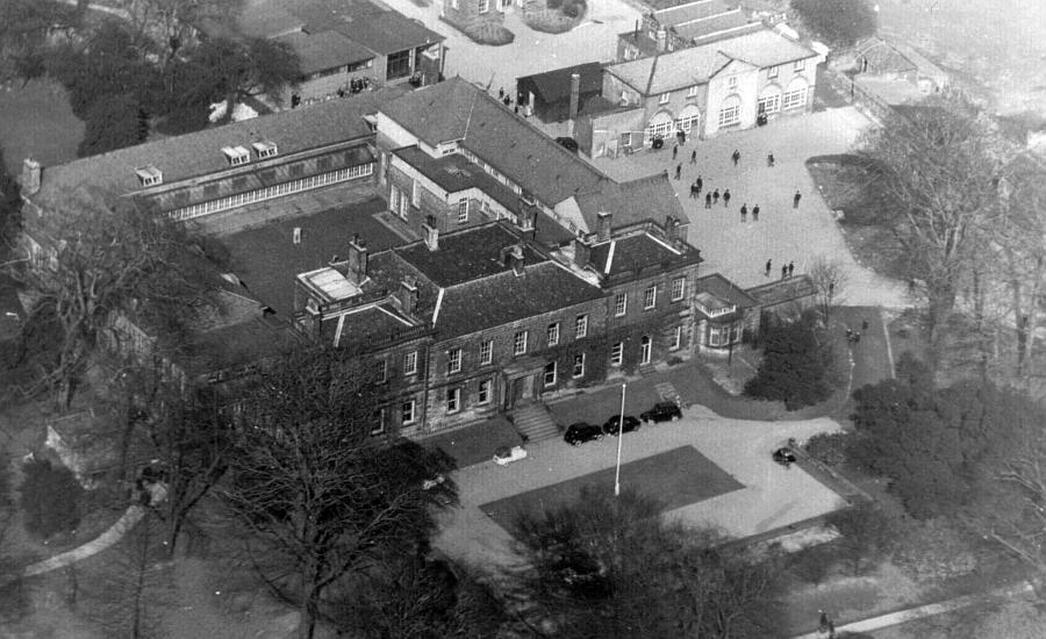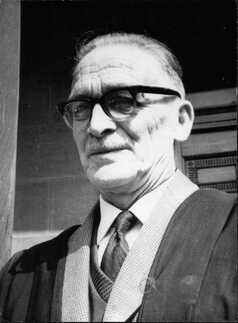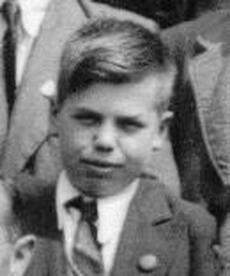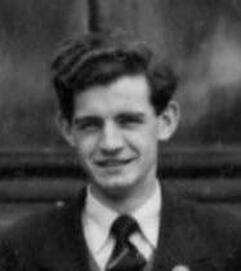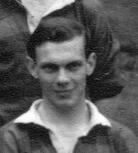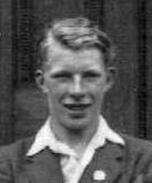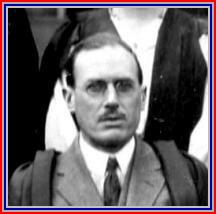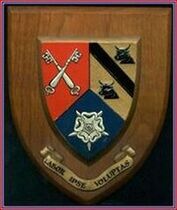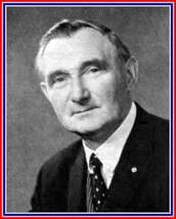Some HGS Historical Detail
The HGS site about 1950
Mr Collette
HGS 1925-65
HGS 1925-65
1. Mr. Collette
From the School Magazines of 1959 and 1960
What was Hemsworth Grammar School like in its early days? Looking over the old magazines can be both entertaining and instructive as our school expands and educational facilities become more complex. Mr. Collette has unearthed some interesting facts and figures.
1923
By December, 1923 the school mustered 154 pupils.
A school party visited Wembley, the Zoo and the Houses of Parliament in June, 1923.
Three short plays: "The Princess and the Woodcutter", "Fleur de Neige" and "Creatures of Impulse" were performed in the Quarry Garden.
"As You Like It" was performed in the Hippodrome for there was, as yet, no School Hall.
1924
Price House came into existence. It was named after the Chairman of the Governors, Alderman G. Price.
"The wireless set has functioned for twelve months and many members of the Wireless Club are making their own crystal sets."
Staff v. School hockey match (1924) - Staff 7 - School 0.
"You are old," said the Team, "and your arms are too weak
For anything fiercer than croquet.
Yet you shot seven goals, and we couldn't get one.
Who taught you your powerful stroke, eh?"
"In our youth," said the Staff, "we have taught many boys
Among whom we've caned not a few, And the muscular strength which it gave to our arms
Still easily carries us through."
"Now we've answered your questions, and that is enough; If more come, we'll surely see red.
Do you think we can listen all day to this stuff? Be off, or we'll 'stripe' you instead.
Say 'Licked by the aged' when tempted to bluff, 'Tis a cure for any swelled head.'
1925
June 26th. The Old Students' Association was formed. W. Kirk was the first President and, Winnie Walsh the Vice-President.
House Challenge Cup: Won by Holgate House.
House Sports Cup: Won by Price House.
1926
Scorer of the first century for the School: Stanley Hawkesworth. This was followed by successive scores of 63, 71, and 119.
Guest House was formed, named after Mr. J. Guest, M.P.
House Challenge Cup: Won by Holgate House.
1927
Introduction of the Inter-House Musical Competition.
Talbot House Choir won the Choir Competition.
Assembly Hall officially opened by Alderman G. Price, J.P.
The first County Major Scholarship won by E. J. Barker.
School Photographic Society started by Mr. Hyde.
1928
First School Concert.
'Leavers' introduced the good idea of donating a book to the Library for all the help it had given them.
1929
Speech Day was held in the Hippodrome.
School Play: 'She Stoops to Conquer'.
From the School Magazines of 1959 and 1960
What was Hemsworth Grammar School like in its early days? Looking over the old magazines can be both entertaining and instructive as our school expands and educational facilities become more complex. Mr. Collette has unearthed some interesting facts and figures.
1923
By December, 1923 the school mustered 154 pupils.
A school party visited Wembley, the Zoo and the Houses of Parliament in June, 1923.
Three short plays: "The Princess and the Woodcutter", "Fleur de Neige" and "Creatures of Impulse" were performed in the Quarry Garden.
"As You Like It" was performed in the Hippodrome for there was, as yet, no School Hall.
1924
Price House came into existence. It was named after the Chairman of the Governors, Alderman G. Price.
"The wireless set has functioned for twelve months and many members of the Wireless Club are making their own crystal sets."
Staff v. School hockey match (1924) - Staff 7 - School 0.
"You are old," said the Team, "and your arms are too weak
For anything fiercer than croquet.
Yet you shot seven goals, and we couldn't get one.
Who taught you your powerful stroke, eh?"
"In our youth," said the Staff, "we have taught many boys
Among whom we've caned not a few, And the muscular strength which it gave to our arms
Still easily carries us through."
"Now we've answered your questions, and that is enough; If more come, we'll surely see red.
Do you think we can listen all day to this stuff? Be off, or we'll 'stripe' you instead.
Say 'Licked by the aged' when tempted to bluff, 'Tis a cure for any swelled head.'
1925
June 26th. The Old Students' Association was formed. W. Kirk was the first President and, Winnie Walsh the Vice-President.
House Challenge Cup: Won by Holgate House.
House Sports Cup: Won by Price House.
1926
Scorer of the first century for the School: Stanley Hawkesworth. This was followed by successive scores of 63, 71, and 119.
Guest House was formed, named after Mr. J. Guest, M.P.
House Challenge Cup: Won by Holgate House.
1927
Introduction of the Inter-House Musical Competition.
Talbot House Choir won the Choir Competition.
Assembly Hall officially opened by Alderman G. Price, J.P.
The first County Major Scholarship won by E. J. Barker.
School Photographic Society started by Mr. Hyde.
1928
First School Concert.
'Leavers' introduced the good idea of donating a book to the Library for all the help it had given them.
1929
Speech Day was held in the Hippodrome.
School Play: 'She Stoops to Conquer'.
Geof Govier
2. Geoff Govier
Dave,
In a newspaper dated November 13th. 1936 there is a brief report of the Hemsworth Grammar School's 15th. Annual Speech Day held at the Hippodrome, Hemsworth. It is reported that "In 1922 there were 140 pupils (71 boys & 69 girls). There are now 416 pupils (207 boys & 209 girls).
In 1922 there was only temporary accommodation for science, no hall or gymnasium, domestic science room, cricket ground, tennis courts nor changing rooms, only two "houses" and one challenge cup. There are now excellent laboratories for physics, chemistry, botany, and domestic subjects, special rooms fully equipped for the teaching of art and geography, a room for practical instruction in pottery, lately equipped with an electric kiln, an excellent workshop equipped with lathes and all necessary machinery for metalwork and engineering, a library, dining hall to seat 200 and more for dinner, an assembly hall fitted with gymnastic apparatus, a cricket ground, two hard tennis courts, a changing room, four houses and 10 challenge cups."
Geoff Govier
Dave,
In a newspaper dated November 13th. 1936 there is a brief report of the Hemsworth Grammar School's 15th. Annual Speech Day held at the Hippodrome, Hemsworth. It is reported that "In 1922 there were 140 pupils (71 boys & 69 girls). There are now 416 pupils (207 boys & 209 girls).
In 1922 there was only temporary accommodation for science, no hall or gymnasium, domestic science room, cricket ground, tennis courts nor changing rooms, only two "houses" and one challenge cup. There are now excellent laboratories for physics, chemistry, botany, and domestic subjects, special rooms fully equipped for the teaching of art and geography, a room for practical instruction in pottery, lately equipped with an electric kiln, an excellent workshop equipped with lathes and all necessary machinery for metalwork and engineering, a library, dining hall to seat 200 and more for dinner, an assembly hall fitted with gymnastic apparatus, a cricket ground, two hard tennis courts, a changing room, four houses and 10 challenge cups."
Geoff Govier
James Ainge
3. Peering Into The Past 1. 1921-25
From the School Magazine 1953
In the last edition of the School Magazine, I wrote an article on the history of the first Hemsworth Grammar School from its foundations in 1546 until its transference to Barnsley in 1885. In this article I mentioned that the present H.G.S. was opened in 1921. This year I should like to tell you of some sides of school life which existed in those early days of the present school.
1921-22.
The School was known as the Hemsworth Secondary School and was opened on November 8th, 1921, although the official opening ceremony did not take place until 10 days later. There were 101 pupils in the school and 4 members of staff. Another 3 teachers joined the school in 1922, one of them being Mr. Crossland, who retired less than 3 years ago. The School was divided into 2 Houses, named Holgate (after Archbishop Holgate) and Talbot (after the Chairman of the Education Committee, who opened the school).
The first Sports Day had to be adjourned because of rain. Included in the events were a 3-legged race, a sack race and an obstacle race (Organisers of next term's Sports Day please take note). After the sports, a demonstration of Country Dancing was given by the boys and girls. This was so successful that it was decided to hold a Country Dancing Festival every year. During the first school year, Association Football was played, but the average age of the school then was so low that it was difficult to find any team of their own age to play. The result was that the school team had to play bigger and older boys than themselves and, consequently, they lost every match except one. The boys also played Fives, and even had Fives House matches. The cricket pitch still needed a little more attention before matches could be played on it. The girls played hockey (although the field was rough for the first few years) and netball. (The first edition of the School Magazine states that the girls played hockey and baseball.)
Other school societies founded during the first year included a Scout Movement, a Hobbies Club, and a Dramatic Society; the latter, of course, is still thriving. There were also a National Savings Club and a collection for the Lord Robert's Memorial Fund. The School Library was begun in January 1922 and contained 69 books. The Library now contains approximately 3,000 books. There were General Intelligence Tests at the end of every school year; any howlers were then reported in the following edition of the School Magazine.
1922-23.
The first Speech Day took place on December 13th, 1922, in the Hippodrome. The School Choir opened the proceedings with part songs; in fact, the whole programme was roughly the same as it is to-day. It was during this school year that Mr. Storer joined the School as Geography and Physics master; he retired at the same time as Mr. Crossland. A gramophone and wireless were installed in the school; the latter by the boys and girls themselves, under Mr. Storer's guidance. A Literary and Debating Society was formed. The Folk Dancing team and the choirs competed at the Pontefract Festivals; there were two theatre parties and the first of the School's Christmas Parties was held. The boys changed from Soccer to Rugby and were instructed by Mr. Crossland. The only home cricket match possible that year was again the parents on Sports Day; the parents won. Included in these earlier magazines were cartoons and lists of new pupils and pupils who were leaving.1923-24. This year saw the formation of Price House (named after Alderman Price, Chairman of the School Governors). A Reading Competition was instituted and 2 Victor Ludorum Cups were awarded on Sports Day, the first winners of these being Mary Lindsay and Kirk, W.
1924-25.
It was decided to print the School Magazine each term, and to reduce the price. In nearly every edition of the Magazine after this announcement there were appeals for more contributions, especially from the senior forms. An Old Students' Association was formed and a special corner was set aside in the Magazine for news of former pupils. Also printed at the end of the Magazine was a calendar giving the school time-table for the following term.
Ainge, J.A. L6A (Guest)
From the School Magazine 1953
In the last edition of the School Magazine, I wrote an article on the history of the first Hemsworth Grammar School from its foundations in 1546 until its transference to Barnsley in 1885. In this article I mentioned that the present H.G.S. was opened in 1921. This year I should like to tell you of some sides of school life which existed in those early days of the present school.
1921-22.
The School was known as the Hemsworth Secondary School and was opened on November 8th, 1921, although the official opening ceremony did not take place until 10 days later. There were 101 pupils in the school and 4 members of staff. Another 3 teachers joined the school in 1922, one of them being Mr. Crossland, who retired less than 3 years ago. The School was divided into 2 Houses, named Holgate (after Archbishop Holgate) and Talbot (after the Chairman of the Education Committee, who opened the school).
The first Sports Day had to be adjourned because of rain. Included in the events were a 3-legged race, a sack race and an obstacle race (Organisers of next term's Sports Day please take note). After the sports, a demonstration of Country Dancing was given by the boys and girls. This was so successful that it was decided to hold a Country Dancing Festival every year. During the first school year, Association Football was played, but the average age of the school then was so low that it was difficult to find any team of their own age to play. The result was that the school team had to play bigger and older boys than themselves and, consequently, they lost every match except one. The boys also played Fives, and even had Fives House matches. The cricket pitch still needed a little more attention before matches could be played on it. The girls played hockey (although the field was rough for the first few years) and netball. (The first edition of the School Magazine states that the girls played hockey and baseball.)
Other school societies founded during the first year included a Scout Movement, a Hobbies Club, and a Dramatic Society; the latter, of course, is still thriving. There were also a National Savings Club and a collection for the Lord Robert's Memorial Fund. The School Library was begun in January 1922 and contained 69 books. The Library now contains approximately 3,000 books. There were General Intelligence Tests at the end of every school year; any howlers were then reported in the following edition of the School Magazine.
1922-23.
The first Speech Day took place on December 13th, 1922, in the Hippodrome. The School Choir opened the proceedings with part songs; in fact, the whole programme was roughly the same as it is to-day. It was during this school year that Mr. Storer joined the School as Geography and Physics master; he retired at the same time as Mr. Crossland. A gramophone and wireless were installed in the school; the latter by the boys and girls themselves, under Mr. Storer's guidance. A Literary and Debating Society was formed. The Folk Dancing team and the choirs competed at the Pontefract Festivals; there were two theatre parties and the first of the School's Christmas Parties was held. The boys changed from Soccer to Rugby and were instructed by Mr. Crossland. The only home cricket match possible that year was again the parents on Sports Day; the parents won. Included in these earlier magazines were cartoons and lists of new pupils and pupils who were leaving.1923-24. This year saw the formation of Price House (named after Alderman Price, Chairman of the School Governors). A Reading Competition was instituted and 2 Victor Ludorum Cups were awarded on Sports Day, the first winners of these being Mary Lindsay and Kirk, W.
1924-25.
It was decided to print the School Magazine each term, and to reduce the price. In nearly every edition of the Magazine after this announcement there were appeals for more contributions, especially from the senior forms. An Old Students' Association was formed and a special corner was set aside in the Magazine for news of former pupils. Also printed at the end of the Magazine was a calendar giving the school time-table for the following term.
Ainge, J.A. L6A (Guest)
4. Peering Into The Past 2. 1925-30
1925-26.
Electric light was installed throughout the school. For the first time in the history of the School pupils sat for the School Leaving
Certificate; 13 out of 21 were successful. Each of the three Houses had its own Coat of Arms and motto:-
Holgate - Cor unum, una via.
TaIbot - Ad astra.
Price - Age quid agas.
Mr. Collette joined the staff during this school year.
The new wing of the school building was completed. The new wing included 2 laboratories and a Domestic Science room.
During the summer term of 1926, Hawkesworth, the Cricket Captain, scored the first century in the history of the school. His
record for that season ran:-
Batting: 15 innings, twice not out.
Scores: 63, 21, 55, 71*, 119, 10, 7, 33, 6, 2, 40, 121*, 3, 0, 2.
Average: 42.54.
* = not out.
Bowling 54.2 overs, 12 maidens, 176 runs, 16 wickets. Average - 11. He also took 10 catches. Also included in the Summer Edition of the Magazine was a competition. One of the teachers had drawn caricatures of 13 members of the school and staff. A prize was to be given to the first person to hand in the correct answers together with one penny, the following term.
1926-27.
26 people sat for the Northern Universities School Certificate in this year; of these 25 were successful. A fourth House was formed, named Guest (after Mr. Guest, the local MP). Their motto was "Labor omnia vincit." Mr. Manning joined the staff during this school year. An Art Club and a Swimming Club were formed and an Inter-House Musical Competition was instituted.The new Gymnasium and Assembly Hall was completed. A large party from the school went to Croft Spa on June 29th. Their object was to obtain a good view of the eclipse of the sun; unfortunately, it was obscured by clouds. On arriving back in Hemsworth one member of the staff who accompanied the party was met by his wife, who told him she had had an excellent view of the eclipse from the bedroom window.
1927-28.
The Higher School Certificate was taken for the first time by pupils at Hemsworth Secondary School; 5 pupils were successful. The first County Major Scholarship was won by Barker. A Photographic Society and a course of lectures were successfully launched. The bicycle shed and a room with showers for the boys were completed. Golf was a flourishing sport at this time. Subscriptions were given every week by nearly all the pupils to provide hard tennis courts; these were in use by the end of the school year. A Swimming Competition was held for the first time. The first school Concert was given during the summer term.
1928-29
A new building scheme was approved for the school. The new buildings would include the new Dining Room, classrooms and a workshop for metalwork and woodwork. Many of the original members of the school had now left, but they still kept in touch with the school. They wrote to the school telling of their present work and these reports were put into the Magazine.
1929-30
One of the original members of the school Rugby team, Stanley Smith, was chosen to represent England against the Australiansin the last Rugby test match at Headingley. 5 boys from the school took part in the great emigration movement of 1930. They went to British Columbia to be trained in fruit-farming. One of the Needlework Prizes given on Speech Day went to M. Metcalfe. (No prizes will be given for knowing who this lady is).
Ainge, J.A. L6A.Guest
1925-26.
Electric light was installed throughout the school. For the first time in the history of the School pupils sat for the School Leaving
Certificate; 13 out of 21 were successful. Each of the three Houses had its own Coat of Arms and motto:-
Holgate - Cor unum, una via.
TaIbot - Ad astra.
Price - Age quid agas.
Mr. Collette joined the staff during this school year.
The new wing of the school building was completed. The new wing included 2 laboratories and a Domestic Science room.
During the summer term of 1926, Hawkesworth, the Cricket Captain, scored the first century in the history of the school. His
record for that season ran:-
Batting: 15 innings, twice not out.
Scores: 63, 21, 55, 71*, 119, 10, 7, 33, 6, 2, 40, 121*, 3, 0, 2.
Average: 42.54.
* = not out.
Bowling 54.2 overs, 12 maidens, 176 runs, 16 wickets. Average - 11. He also took 10 catches. Also included in the Summer Edition of the Magazine was a competition. One of the teachers had drawn caricatures of 13 members of the school and staff. A prize was to be given to the first person to hand in the correct answers together with one penny, the following term.
1926-27.
26 people sat for the Northern Universities School Certificate in this year; of these 25 were successful. A fourth House was formed, named Guest (after Mr. Guest, the local MP). Their motto was "Labor omnia vincit." Mr. Manning joined the staff during this school year. An Art Club and a Swimming Club were formed and an Inter-House Musical Competition was instituted.The new Gymnasium and Assembly Hall was completed. A large party from the school went to Croft Spa on June 29th. Their object was to obtain a good view of the eclipse of the sun; unfortunately, it was obscured by clouds. On arriving back in Hemsworth one member of the staff who accompanied the party was met by his wife, who told him she had had an excellent view of the eclipse from the bedroom window.
1927-28.
The Higher School Certificate was taken for the first time by pupils at Hemsworth Secondary School; 5 pupils were successful. The first County Major Scholarship was won by Barker. A Photographic Society and a course of lectures were successfully launched. The bicycle shed and a room with showers for the boys were completed. Golf was a flourishing sport at this time. Subscriptions were given every week by nearly all the pupils to provide hard tennis courts; these were in use by the end of the school year. A Swimming Competition was held for the first time. The first school Concert was given during the summer term.
1928-29
A new building scheme was approved for the school. The new buildings would include the new Dining Room, classrooms and a workshop for metalwork and woodwork. Many of the original members of the school had now left, but they still kept in touch with the school. They wrote to the school telling of their present work and these reports were put into the Magazine.
1929-30
One of the original members of the school Rugby team, Stanley Smith, was chosen to represent England against the Australiansin the last Rugby test match at Headingley. 5 boys from the school took part in the great emigration movement of 1930. They went to British Columbia to be trained in fruit-farming. One of the Needlework Prizes given on Speech Day went to M. Metcalfe. (No prizes will be given for knowing who this lady is).
Ainge, J.A. L6A.Guest
5. Peering Into The Past 3. 1930-34
1930-31.
A new wireless was installed; this one worked from the mains. Junior Rugby House matches were introduced, and Sports Committees for Boys' games, were established. All the House Notes published this school year included the names of boys who had collected too many stripes. Rounders were introduced into the school and junior girls entered enthusiastically into the spirit of the game. In May 1931, the first Annual Inter-School Sports were held at Huddersfield. Six schools competed and Hemsworth were awarded the W.R.C.C. Challenge Shield for the school securing the highest number of points, and also the Plaque for the most successful intermediate section.
1931-32.
The Old Students Association became the Old Hilmians' Association. At the Huddersfield Inter-School Sports meeting Hemsworth secured the Challenge Shield again; the school gained 42 points; the next school, Holmfirth, gained 20 points. Hemsworth also won the Junior and Senior Plaques. The Guest House Captain from 1931-33 was Miss. M. Metcalfe. A new Biology teacher named Miss Kenward joined the staff during this school year. Those of you who take Biology, and others too, will know of the Kenward Biology Medal, awarded each year to the most outstanding student of Biology. This was instituted by Miss Kenward.
1932-33
The new school buildings were completed. The School changed its name from the Secondary School to the Grammar School, at the beginning of the Spring term, 1933. Once more, Hemsworth gained the Challenge Shield and two of the three Plaques at the Huddersfield Sports.
1933-34. Price House decided to award a badge, with the House motto on it, to the member of the House who most distinguished himself or
herself. Advertisements were inserted in the last two copies of the School Magazines by local tradesmen.
Ainge, J. A. L6A. Guest.
1930-31.
A new wireless was installed; this one worked from the mains. Junior Rugby House matches were introduced, and Sports Committees for Boys' games, were established. All the House Notes published this school year included the names of boys who had collected too many stripes. Rounders were introduced into the school and junior girls entered enthusiastically into the spirit of the game. In May 1931, the first Annual Inter-School Sports were held at Huddersfield. Six schools competed and Hemsworth were awarded the W.R.C.C. Challenge Shield for the school securing the highest number of points, and also the Plaque for the most successful intermediate section.
1931-32.
The Old Students Association became the Old Hilmians' Association. At the Huddersfield Inter-School Sports meeting Hemsworth secured the Challenge Shield again; the school gained 42 points; the next school, Holmfirth, gained 20 points. Hemsworth also won the Junior and Senior Plaques. The Guest House Captain from 1931-33 was Miss. M. Metcalfe. A new Biology teacher named Miss Kenward joined the staff during this school year. Those of you who take Biology, and others too, will know of the Kenward Biology Medal, awarded each year to the most outstanding student of Biology. This was instituted by Miss Kenward.
1932-33
The new school buildings were completed. The School changed its name from the Secondary School to the Grammar School, at the beginning of the Spring term, 1933. Once more, Hemsworth gained the Challenge Shield and two of the three Plaques at the Huddersfield Sports.
1933-34. Price House decided to award a badge, with the House motto on it, to the member of the House who most distinguished himself or
herself. Advertisements were inserted in the last two copies of the School Magazines by local tradesmen.
Ainge, J. A. L6A. Guest.
Terry McCroakam
6. Six HGS facts
1. The First Speech Day of HGS was held at the Hippodrome, Hemsworth on November 29th 1922.
2. In Sept 1958 the first form was renamed from 1a, b, c, d, etc to Celts, Romans, Danes and Normans.
3. In Sept 1960 The Friday Club was established from an amalgamation of the Historical Society, The Literary and Debating
Society and the Student Christian Movement.
4. Mr Hamilton retired Dec. 1967
5. For many years a two-year course of Esperanto was on the timetable for every pupil at HGS. On the removal of Esperanto from
the curriculum in 1959, on the 21st January 1960 the Esperanto Club was re-formed. Esperanto was taught by Mr. Lock and Mr.
R.W. Hamilton. Mr. Davies and Mr. Jakes helped with the Society.
6. RWH was still playing cricket Friday evenings with the Staff and Saturday and Sunday afternoons with the Old Hilmians right up
to his retirement at 65. He was doing his share of bowling as well.
Terry McCroakam
1. The First Speech Day of HGS was held at the Hippodrome, Hemsworth on November 29th 1922.
2. In Sept 1958 the first form was renamed from 1a, b, c, d, etc to Celts, Romans, Danes and Normans.
3. In Sept 1960 The Friday Club was established from an amalgamation of the Historical Society, The Literary and Debating
Society and the Student Christian Movement.
4. Mr Hamilton retired Dec. 1967
5. For many years a two-year course of Esperanto was on the timetable for every pupil at HGS. On the removal of Esperanto from
the curriculum in 1959, on the 21st January 1960 the Esperanto Club was re-formed. Esperanto was taught by Mr. Lock and Mr.
R.W. Hamilton. Mr. Davies and Mr. Jakes helped with the Society.
6. RWH was still playing cricket Friday evenings with the Staff and Saturday and Sunday afternoons with the Old Hilmians right up
to his retirement at 65. He was doing his share of bowling as well.
Terry McCroakam
Leighton Smith
Leighton Smith comments about Esperanto.
"I noticed in the forum: 15. "Five HGS facts and question" it mentions that the Esperanto Club was formed in 1960. This must have been a re-form. It was certainly going strong in the late 1940s. I had the privilege of being in a group of about fourteen Esperanto Club pupils and two staff (Mr Hamilton and a female staff member whose name I cannot recall) who went to France for about three weeks in August 1949. We first attended the International Esperanto Conference in Paris. This lasted three or four days, then we went to Grenoble where we were billeted with families from a school there. I think that we were there for more than a week. Then we went back to Paris for a few days sightseeing, Palace of Versailles, the Louvre etc. I am not sure now how it happened, but at one stage I found myself on my own with Mr Hamilton for a couple hours, wandering around Paris. At one street cafe/bar he introduced me to Pernod."
"I noticed in the forum: 15. "Five HGS facts and question" it mentions that the Esperanto Club was formed in 1960. This must have been a re-form. It was certainly going strong in the late 1940s. I had the privilege of being in a group of about fourteen Esperanto Club pupils and two staff (Mr Hamilton and a female staff member whose name I cannot recall) who went to France for about three weeks in August 1949. We first attended the International Esperanto Conference in Paris. This lasted three or four days, then we went to Grenoble where we were billeted with families from a school there. I think that we were there for more than a week. Then we went back to Paris for a few days sightseeing, Palace of Versailles, the Louvre etc. I am not sure now how it happened, but at one stage I found myself on my own with Mr Hamilton for a couple hours, wandering around Paris. At one street cafe/bar he introduced me to Pernod."
